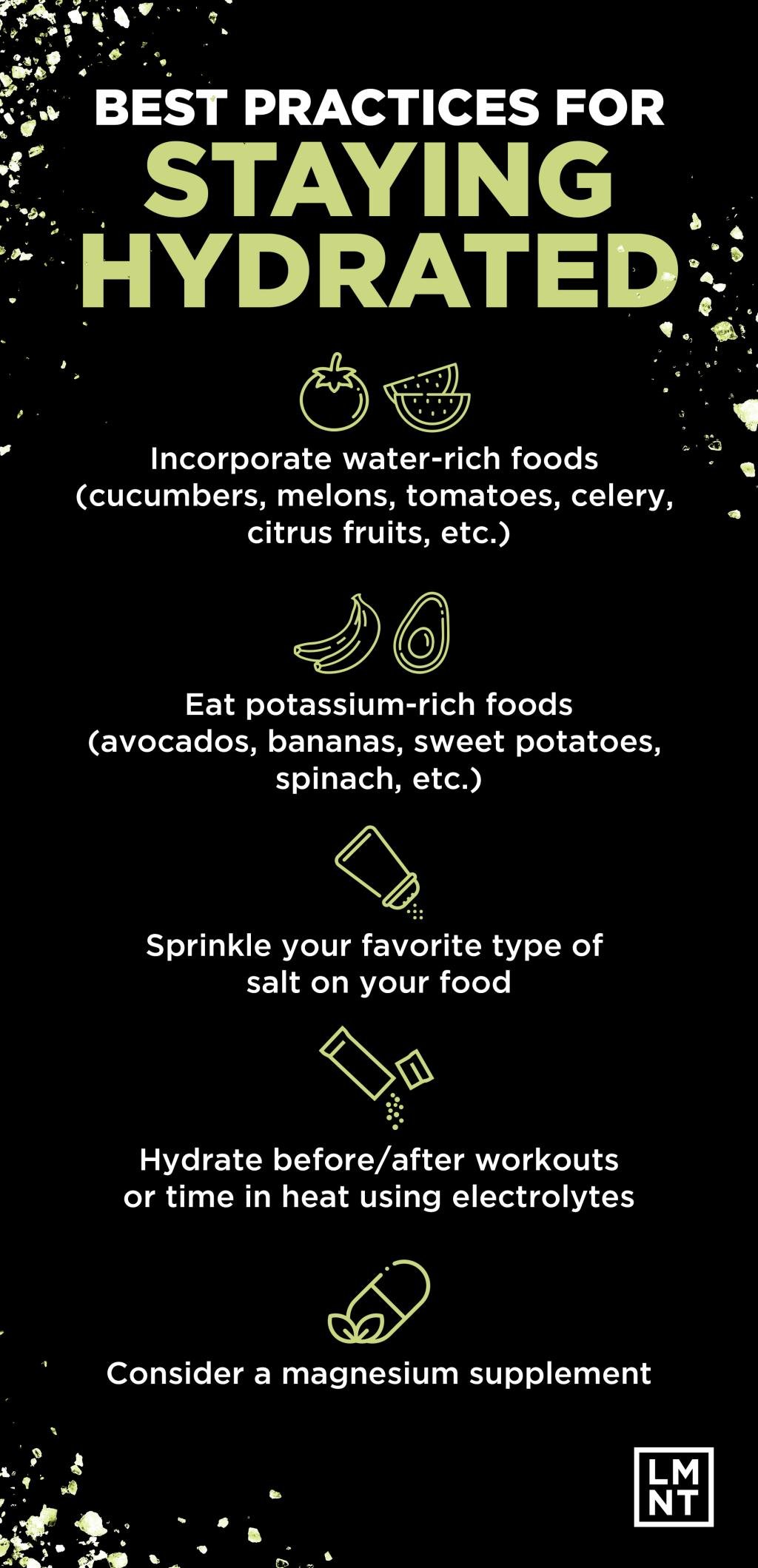
Dry skin? Here are 3 helpful tips to restore from the inside out
Dry skin? Here are 3 helpful tips to restore from the inside out
As with all aspects of health, skin health is a holistic concept. You need to do a lot of things right — get adequate rest, eat a nutrient-dense diet, find the right lotions, and many other things — to keep your skin from resembling a catcher’s mitt.
But what many people fail to consider is that hydrating your skin also depends on hydrating your body as a whole. If you don’t replace fluids and electrolytes after a sauna, for instance, you can develop dehydrated skin.
That said, most people get plenty of fluids. We’ve been told from a young age to drink at least eight glasses of water per day, regardless of your thirst or how much water you’re getting from other sources. (Yes: Coffee, tea, and many foods provide water, too!)
A better strategy is to drink to thirst, but water is just the half of it. Electrolytes like sodium and potassium help balance fluids throughout your body, which supports healthy skin; however, the exact mechanisms are still being studied.
In fact, if you drink too much plain water, it can dilute the concentration of electrolytes (like sodium, potassium, and chloride) in your blood — which could lead to a condition called hyponatremia, when sodium levels drop too low.
When that happens, your body tries to restore balance (homeostasis) by pulling electrolytes from other tissues or storage sites, such as bone, muscle, or interstitial fluid (the liquid that surrounds your body’s cells), to bring blood levels back up to normal.
In this article, LMNT covers the basics of skin hydration, as well as the causes and remedies for dehydrated skin.
Why Skin Hydration Matters for Healthy Skin
Most bodily tissues depend on water — we’re mostly water weight, after all — and skin is no exception. In particular, water keeps the outer layer of your skin (called the stratum corneum) functioning properly.
The stratum corneum is how the world sees your skin. It’s the barrier that protects the rest of your body from the outside world. It’s also the barrier that keeps materials (like fluids) from spilling out.
In fact, maintaining skin moisture depends on the ability of the stratum corneum to prevent transepidermal water loss and your hydration status. If you don’t consume adequate fluids and electrolytes, your skin may begin to show it, appearing dull, tight, and thirsty for hydration.
Beyond hydration habits, other factors influencing skin health include:
- The levels of various lipids, sugars, and proteins (glycerol, hyaluronan, water-transporting protein aquaporin-3) found in skin cells
- Genetic factors
- Micronutrient intake (zinc, selenium, and vitamin A are all crucial for skin health)
- UV exposure
- Alcohol consumption habits
- Sleep habits
Today is a deep dive into skin hydration, but don’t neglect the other factors. Skin health is a holistic endeavor.
Is Dry Skin the Same as Dehydrated Skin?
According to several skincare and dermatology-related websites, dry skin is distinct from dehydrated skin. The claim is:
- Dry skin is a skin type characterized by low sebum levels (aka, the natural oils your sebaceous glands produce to help lubricate and hydrate the skin).
- Dehydrated skin is a condition characterized by low skin moisture, often caused by environmental dryness, impaired skin barrier function, or insufficient water content in the outer skin layers.
Medical literature doesn’t support this distinction, though. In one paper published in The Journal of Dermatological Treatment, the authors report that “dry skin is a common condition that is attributed to a lack of water in the stratum corneum.”
Note how dry skin is labeled a “condition,” not a skin type, and that poor skin moisture is the proximate cause. Other researchers point out that the outermost layer of “skin requires a water content of 10-15% to remain supple and intact.” Again, the focus is on skin hydration.
Basically, healthy skin is synonymous with hydrated skin. In turn, hydrated skin depends on many factors, including your hydration habits, natural skin oils, and nutritional status.
In other words, although dehydration can cause dry skin, the two aren’t always identical. Dryness often results from impaired skin barrier function (low natural oils), while dehydration reflects low water content. Both can coexist, and both benefit from adequate hydration and topical care.
This doesn’t mean that dehydration is the only cause of dry skin, but it does suggest the two shouldn’t be viewed as totally distinct and separate.
Symptoms of Dehydrated Skin
Dry skin is a well-documented symptom of dehydration. Other symptoms include:
- Itchy skin
- More pronounced wrinkles and fine lines
- Cracked lips
- Dark circles under the eyes
- A lack of color or dullness to the skin
- Pallor
These symptoms suggest something is wrong with your skin hydration. They don’t necessarily mean you need more fluids.
To triangulate, look for other dehydration symptoms like thirst, dark urine, or feelings of fatigue. In particular, thirst and dark urine are clear signs to drink more water. But be sure to include sodium in that water.

Common Causes of Dehydrated Skin
The causes of dehydrated skin are coincident with the causes of dehydration. When someone becomes dehydrated, it’s generally due to excess water loss through the gut, urine, skin, or breath. Some examples will help illustrate.
- Diarrhea, vomiting, and simple digestion all deplete body water.
- Kidney issues, diuretics, or any intervention (like a low-carb diet or fasting) that has a diuretic effect cause significant urinary water losses.
- The more you sweat, the more water and sodium you lose. Why do you think exercise demands extra hydration?
- Physical activity in dry or high-altitude environments increases respiratory water losses.
What about alcohol? That belongs in the urine losses category. Alcohol temporarily suppresses vasopressin (a fluid-retention hormone), which is why you need numerous bathroom trips after a few cocktails. Heavy or frequent drinking can lead to mild dehydration, enough to affect how your skin looks and feels.
All those pee breaks dehydrate you. The next morning, your skin pays the price.
Did you notice how insufficient fluid intake wasn’t mentioned as a primary cause of dehydration? With some exceptions (age-related mobility issues, cold climates, elevation), most healthy people do a fine job of drinking enough water.
That’s because the body has a brilliant mechanism called thirst: an effective guide for most healthy people (though extreme exertion, illness, or aging can blunt thirst cues). Thirst tells us when to drink and when to stop drinking. And the “when to stop” is just as important as the “when to start.”
Why? Because more water is not always better. Not knowing when to stop can lead to overhydration, dilute your blood sodium levels, and leave you hanging with a slew of low-sodium symptoms.
Sodium and hydration
If you want to stay hydrated for energy, cognition, and skin health, you need to get enough sodium. Sodium is the yin to water’s yang. Both are essential for hydration.
The mistake most people make? They drink lots of water while diligently limiting salt consumption. After all, mainstream health messaging says that water is “healthy” and sodium is “bad for your heart.”
Here’s the thing: Although uncommon, drinking excessive amounts of water without electrolytes can dilute blood sodium levels (causing hyponatremia), especially during prolonged exercise or illness. And while very high salt intakes can elevate blood pressure, low sodium intake (below 2-3 grams per day) may also raise blood pressure through hormonal responses.
How does this relate to skin health? Because sodium helps regulate overall fluid balance and circulation, which indirectly supports tissue hydration — including the skin.
In other words, sodium keeps water balanced in your blood vessels, sweat, tears, and skin.
3 Hydration Tips to Restore Dehydrated Skin
If you have dehydrated skin, a fancy cream won’t fix it alone. Like much of our modern health issues, dehydrated skin oftentimes originates in our diet. You need to fix the problem from the inside out. Here are some simple tips to do that.
#1: Be mindful of dehydrating situations
Dehydrating situations increase your risk of dry skin. Adjust your behavior (and hydration strategy) accordingly.
For instance, if you’re playing a tennis match on a humid afternoon, you’ll want to bring along plenty of electrolyte water. And if you’re sick with a stomach bug, you’ll want to replace fluids, sodium, and potassium as best you can. Drinking beyond 1-2 alcoholic beverages will also increase water and electrolyte losses.
#2: Drink when thirsty
As mentioned earlier, drinking to thirst is enough to prevent dehydration for most people.
Thirst is controlled by the hypothalamus, an ancient brain region that regulates a host of automatic functions. To heed thirst is to heed the wisdom of your body.
Ignoring thirst is the opposite of wisdom. If you don’t drink when thirsty, you’re guaranteed to become dehydrated. And if you drink past thirst (common), you’ll enter the unhappy realm of low sodium.
In some cases, kids, older folks, and people who are sick may need reminders to drink.
#3: Get enough electrolytes
If you neglect electrolytes like sodium and potassium, your fluid-balancing system won’t work. As a result, blood flow, brain health, and skin hydration will suffer.
Getting enough electrolytes means:
- Eating electrolyte-rich foods like leafy greens, avocados, and nuts.
- Salting your meals like you mean it.
- Supplementing when necessary.

FAQs
How do I know if my skin is dehydrated?
Look for these common symptoms of dehydrated skin: dryness, itchiness, more pronounced wrinkles and fine lines, cracked lips, dark circles under the eyes, dullness or lack of color, and pallor. To confirm it's a hydration issue, check for other dehydration symptoms like thirst, dark urine, or fatigue. Thirst and dark urine are particularly clear signs you need more fluids and electrolytes.
Can drinking water alone fix dehydrated skin?
No. While water is essential, it's only half the equation. You also need electrolytes — especially sodium and potassium — to maintain proper fluid balance throughout your body, including in your skin. Drinking too much water without adequate sodium can deplete your blood electrolyte levels, worsening the problem.
What causes dehydrated skin?
Dehydrated skin typically results from excess water loss rather than insufficient water intake. Common causes include diarrhea and vomiting, diuretics or medications with diuretic effects (including low-carb diets), excessive sweating from exercise, respiratory water loss from physical activity (especially in elevated or cold climates), and alcohol consumption (which suppresses the fluid-retention hormone vasopressin). All these situations increase your need for both water and electrolytes.
What electrolytes does skin need to stay hydrated?
Your skin needs adequate sodium and potassium to maintain proper hydration. Get these by eating electrolyte-rich foods like leafy greens, avocados, and nuts; liberally adding salt to your meals; and supplementing as needed.
Restoring Dehydrated Skin
Hydration habits play a big part in how your skin looks, but hydration isn’t everything. Adequate rest, a nutrient-dense diet, and many other things help keep your skin happy and healthy.
Hydration is just the beginning, but it’s the foundation upon which healthy skin is built.
This story was produced by LMNT and reviewed and distributed by Stacker.



